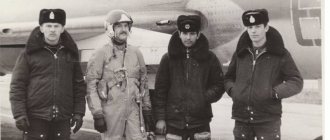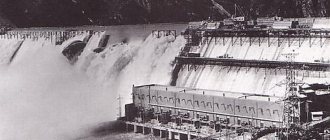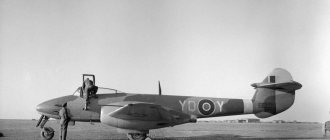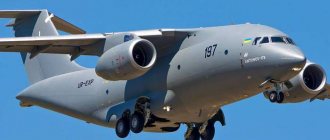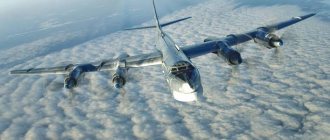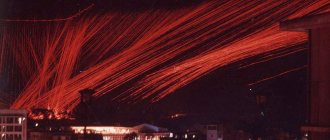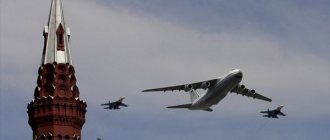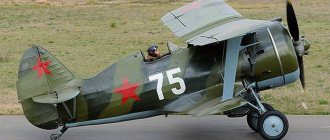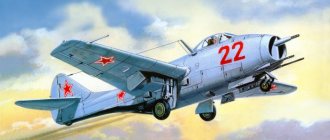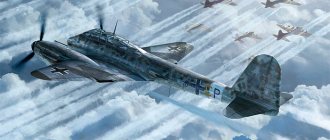The Gloucester Gladiator was the last biplane fighter to enter service with the Royal Air Force. Development was carried out according to the F.7/30 specification, which provided for a departure from the fighter standards of the 20s. - a relatively slow-moving vehicle armed with a pair of 7.7 mm machine guns. The new requirements stipulated that the speed of the fighter must be at least 400 km/h, and the armament would consist of four 7.7 mm machine guns. The design of fighters to meet these requirements was carried out by several British companies at once, but at one time the fate of these aircraft was generally in question - it was expected that modern monoplane fighters would soon enter service with the Royal Air Force. However, it soon became clear that between the retirement of old biplanes and the arrival of new monoplanes, there might be a gap that needed to be filled. It was assumed that the new fighter in 1935-1936. will replace "Bristol" "Bulldog".
The Gloster project under the designation SS.37, the development of which was headed by G.P. Folland, was a deep modernization of the Gauntlet, which had just been put into service. The car was supposed to receive a more powerful version of the Mercury engine, and its aerodynamics were significantly improved - in particular, they used a closed pilot's cabin and strutless landing gear with spring shock absorbers installed inside them. True, the weapons initially did not meet the specifications and consisted only of two synchronized Vickers Mk.NI machine guns (600 rounds of ammunition). The reasonable conservatism of the Gloster designers, who, unlike their competitors, were not keen on technical innovations, ensured the success of the project. The prototype, still with the old Mercury VIS.2 engine (640 hp), was tested in September 1934. The test results were quite successful, and the Royal Air Force ordered the first production batch (according to the revised specification F.14/35) , giving the car the name “Gladiator”.
Production was carried out by the plant in Hakklekot, deliveries began in February 1937. Total production was 747 vehicles.
Main modifications of Gloster "Gladiator"
"Gladiator" Mk . l - Mercury IX engine (840 hp). Armament on the first 70 vehicles - 2 synchronized 7.7-mm Browning machine guns (600 rounds each) and 2 Lewis machine guns under the wing (97 rounds each); on the rest, the underwing machine guns were replaced by Brownings (400 rounds each). In 1937-1938 378 vehicles were manufactured.
Gladiator Mk.ll - Mercury VIIIA engine. Instead of a two-bladed wooden propeller, a three-bladed metal propeller was used. 270 aircraft were produced.
The Sea Gladiator is a carrier-based variant for Royal Navy aviation, created in mid-1938 as a temporary solution until new carrier-based fighters of special design entered service. Created on the basis of the Gladiator Mk.ll, from which it differed in the reinforced lower wing, the presence of a brake hook and a modified composition of instrumentation. 98 aircraft were produced in two sub-variants: “Sea Gladiator” (transitional) - 38 units and “Sea Gladiator” Mk.1 with a full complement of marine equipment, including an inflatable lifeboat (60 aircraft).
British gladiators in the Finnish arena (part 1)
In September 1933, the British Air Ministry (BMA) ordered 24 copies of a new biplane fighter, called the Gauntlet. The fighter was “polished” by the company’s chief designer, Henry Folland, for several years and finally received the recognition it deserved. The first aircraft from the ordered batch was ready in December 1934, and in May of the following year the aircraft began to enter service with the Royal Air Force.
The first production Gauntlets were just being assembled in the factory workshops, and Henry Folland had already prepared a modernized version, developed to meet the requirements of the Ministry of Aviation specification F.7/30, which implied a maximum speed of up to 400 km/h and an armament of four machine guns. In September 1934, test pilot P. Sayer took off a modified Gauntlet under the designation SS.37. It was distinguished from the serial Gauntlets mainly by the simplified design of the wings, equipped with landing flaps, a new landing gear and wing struts, as well as weapons. In its first flight, the prototype reached a speed of 390 km/h (the serial Gauntlet with the same engine reached a maximum of 370 km/h), which attracted the attention of the Ministry of Aviation.
In the spring of 1935, the military bought the SS.37, and Gloucester continued work on the aircraft that already belonged to the British Air Force under their “sensitive leadership.” The fighter was equipped with the latest Mercury IX engine, which produced 820 hp. instead of 640 hp Mercury's predecessor has VIS. In addition, a fully closing cockpit canopy was installed on the aircraft. Especially for the aircraft, the Ministry of Aviation quickly released specification F.14/35 and immediately ordered Gloucester a batch of 23 new aircraft, called the Gladiator Mk.I. In September 1935, a larger order for 180 vehicles followed. Serial production began in the summer of 1936, and from February 1937, the Gladiators began to enter service, gradually displacing the Gauntlets from the ranks of the Royal Air Force.
The third production copy of the Gladiator Mk.I in flight / Photo: wikipedia.org
In 1937, Gloucester produced another batch of "ones" before the Air Ministry issued a new specification F.36/37 for the new modification "Gladiator" Mk.II. It differed only slightly from its predecessor. The two-bladed wooden propeller was replaced with a three-bladed metal one, and all weapons were unified: if previously the Gladiators had two 7.69-mm Browning machine guns installed in the fuselage, and two Lewis guns of the same caliber were installed in small fairings under the lower wings, then Four Brownings received a D. The engine was replaced with a Mercury VIIIA with 840 hp.
Production of the Gladiator Mk.II began in 1938. The Ministry of Aviation ordered a total of 350 aircraft of this type, including 98 in the carrier-based fighter version, called the Sea Gladiator and distinguished mainly by the installation of equipment for landing on an aircraft carrier and launching from a catapult. In 1938, the Gladiator became the main type of fighter of the Royal Air Force, but the following year it began to be replaced from the first-line squadrons by more advanced monoplane fighters Hurricane and Spitfire. However, by the beginning of World War II, 152 Gladiators were still in service with British squadrons, from where they were finally removed only by the end of 1941.
"Gladiators" Mk.I and prototype of the "Gladiator" Mk.II on, 1937 / Photo: surfcity.kund.dalnet.se
The Gladiator aroused great interest not only among the British Air Ministry, but also abroad. Gloucester Aircraft built 147 singles and 33 doubles for export, which were distributed to the air forces of Norway, Belgium, Latvia, Lithuania, Ireland, Greece, Portugal, Egypt, the Union of South Africa, Iraq and China. The Finnish Ministry of Defense also in 1935-1936. considered, among others, the new British fighter as a contender for armament of its fighter squadrons, but in the end made a choice in favor of the Dutch Fokker D.XXI monoplane. Neighboring Sweden acquired for its Air Force in 1936-38. a total of 37 Mk.I and 18 Mk.II, locally designated J8 and J8A respectively. By the beginning of World War II, the Swedish Air Force had 51 Gladiators, which were the main Swedish fighter.
"Gladiator" of the Latvian Air Force / Photo: worldofwarplanes.eu
“Receive us, Suomi beauty!”
The Finns again paid attention to the Gladiator only after the outbreak of the Soviet-Finnish War, better known throughout the world as the Winter War. As of November 30, 1939, the Finnish Air Force fighter aviation included only four dozen D.XXIs and one and a half dozen even more ancient Bulldog Mk.IV fighters. Frantic attempts to buy some relatively modern fighters to replace the Bulldogs, undertaken by the Finnish military in the fall of 1939, led to the conclusion of a contract for the supply of Italian Fiat G.50s, but these machines still had to wait.
From the very beginning of the war, the Finnish leadership turned to Western countries with a request to sell modern military equipment and weapons, including aircraft. It should be noted that initially European countries were in no hurry to respond to Finland’s call, since no one believed that it would be able to resist the Soviet Union for long. However, on December 5, Great Britain, in response to a request from the Finnish Ambassador in London G.A. Gripenberg (Georg Achates Gripenberg), agreed to sell two dozen Gladiators Mk.II to the Finns. The official order arrived on December 12, and the Finnish side formally negotiated directly with Gloucester Aircraft, since the British government did not yet want to complicate relations with the USSR because of this. An agreement was immediately signed for the purchase of 20 Gladiators in the amount of 80,000 pounds sterling, and 10 more vehicles were later provided by the British free of charge.
The main fighter of the Finnish Air Force during the “Winter War” Fokker D.XXI / Photo: www.airwar.ru
The Gladiator was noticeably superior in its performance characteristics to the Finnish Bulldogs, but compared to the main fighter of the Finnish Air Force, the Fokker, the D.XXI generally looked paler. It gained altitude more slowly, dived worse, but was almost as good in maximum speed (“the deuce” accelerated to 410 km/h versus 418 km/h for the Fokker) and was superior in horizontal maneuver. However, horizontal maneuverability for Finnish fighters was not a primary indicator, because The Finns did not plan to conduct maneuver battles with Soviet aircraft, realizing that in this case the advantage would one way or another be on the side of the more numerous fighters of the Red Army Air Force. The main thing was to be able to conduct targeted fire without problems and quickly disengage from combat in unfavorable conditions, and in this sense, the stability of the Fokker when firing and excellent diving qualities from the point of view of the Finnish pilots were much more valuable than the ability to maneuver the enemy horizontally.
Since the concession of the Gladiators did not greatly affect the defense capability of Great Britain itself, where these vehicles from the first line of the Royal Air Force were replaced by more modern fighters, the British command could afford to ship the Gladiators to the Finns directly from the squadrons that were re-equipped with more modern equipment. Moreover, Gripenberg was promised to sell 30 more Gladiators in the future (looking ahead, we note that this promise was never fulfilled).
It is interesting that the Finns, encouraged by their success, tried to buy from the British the 25-30 Gauntlets remaining by that time, but this batch was intercepted from them by the Union of South Africa in order to give these aircraft to the Finns in early February 1940! “Gauntlets” began arriving in Finland in March 1940 and immediately entered training units, where they served faithfully until January-February 1945, after which the surviving vehicles were mothballed and finally decommissioned in January 1950.
Gloster Gauntlet from the 17th training squadron of the Finnish Air Force, Luonetjärvi airfield, April 1944 / Photo: sa-kuva.fi
Since the flight performance of the Gladiators at the end of 1939 was no longer exciting, the Finnish command initially did not plan to arm the fighter squadrons themselves, consolidated into the 2nd Air Regiment, both existing and being formed, with them. The arrival of much more modern machines was expected in the near future - the Fiats were already mentioned above, and on December 12, the United States agreed to supply 44 F2A Buffalo fighters for $3.4 million. At the end of December, the French decided to give the Finns fifty Morand-Saulnier MS.406C-1 fighters. In this regard, it was immediately decided to send the “British” to complete the squadrons of the 1st Air Regiment, which were intended for direct interaction with the army.
The fact is that from the very beginning of hostilities it became obvious that even the Fokkers S.H., the most modern reconnaissance and light bombers available to the Finnish Air Force, could not independently operate during the day over the front line due to Soviet air supremacy. aviation. There was no need to talk about the more ancient Raipons and Fokkers CV. According to the plan of the Finnish aviation command, the Gladiators were to re-equip one or two units in each squadron of the 1st regiment so that they could independently conduct reconnaissance during the day or cover the actions of specialized reconnaissance officers.
However, plans, as we know, do not always coincide with reality. In mid-December, an international scandal broke out: on December 8, London correspondents of the Swedish newspapers Svenska Dagbladet and Dagens Nyheter reported that Germany was supplying Finland with 20-mm anti-aircraft guns and had allowed the transit of 50-60 Italian Savoy bombers through its territory. The USSR immediately protested to Germany, and the German Foreign Ministry denied this accusation, although the delivery of guns was indeed underway, and the Italian Fiats were already preparing to head to Finland through German territory. As a result, the Germans immediately stopped the transit and supply of weapons already purchased by the Finns, the Finns did not receive about 60 anti-aircraft guns, and the fighters went back to Italy and from there by sea, around Europe, to Sweden. Only two G.50s managed to reach Finland in December.
For the Finnish Air Force, this meant that the 26th Squadron of Major Raoul Harju-Jeanty, which had already prepared to receive Italian fighters, was left without materiel for an indefinite period of time: it transferred its Fokkers to the 24th Squadron even before the war , and the “Bulldogs” were withdrawn from its composition as an independent squad after the start of the fighting.
Meanwhile, the British Air Force quickly shipped two dozen Gladiators to the Finns. The planes were dismantled and transported by sea to Sweden, where Swedish mechanics who were well acquainted with the Gladiators assembled them at the aircraft plant in Malmo. After this, the finished aircraft flew to Barkarby, from where Finnish pilots flew them to Finland. The first four Gladiators arrived on January 18 and were immediately sent to arm the 26th Squadron, which they temporarily decided to equip with British fighters. Within a month, until February 18, all 30 Gladiators arrived in Finland, where they received tail numbers ranging from GL-251 to GL-280. By February 1, two of the three flights of the LLv 26 squadron based at the Utti airfield (east of the large railway junction of Kouvola) already had 11 Gladiators in service. The squadron was partially staffed with reservists, but mostly it was not newcomers who sat in the cockpits of English biplanes. Personnel from the 24th Squadron were returned, “on loan” along with the Fokkers, and had already fought in war and even had victories.
Due to the rush, the arriving planes were not repainted to Finnish standards, and they flew in a rather intricate English livery: green and brown camouflage on top, silver fuselage bottom and black and white lower wings. The Finns just painted over the British insignia with their own and added numbers. The only winter attribute on the fighters was the ski chassis, which was installed immediately in Sweden.
Fighter as... fighter
The first serious incident with the Gladiators occurred on January 30: while taxiing at the airfield, the GL-252 damaged the plane and “fell out of the clip” until the end of the war. In general, the Gladiators' debut on the Finnish front was more than successful. The first victory on this type of aircraft in the Finnish Air Force was won by Lieutenant Paavo David Berg, who on February 2 shot down a “Seagull” in the Hanko area from the 3rd squadron of the 38th IAP of the Special Aviation Brigade of the Red Army Air Force (pilot Senior Lieutenant Bedarev was killed captivity). An hour and a half later, the SB Art. became the victim of another “Gladiator”, this time under the control of a Danish volunteer, Lieutenant Jorn Juel Ulrich. Lieutenant Pinchuk from the 57th SBAP of the Red Banner Baltic Fleet Air Force, who flew out on photographic reconnaissance. After a stubborn battle (the SB crew stated that they shot down one of the two attacking enemy aircraft), Ulrich managed to set fire to the bomber, which landed on the ice, and the crew was later evacuated. Already on February 7, the entire crew of Pinchuk was awarded the title of Hero of the Soviet Union.
The most spectacular battle that day was carried out by Senior Sergeant Oiva Emil Kalervo Tuominen, later one of the best Finnish aces. In his Gladiator, he single-handedly attacked a group of Soviet aircraft consisting of a pair of DB-3s from the 85th Special Purpose Aviation Regiment, escorted by six I-16s of the 149th IAP. At the same time, Tuominen was “lucky” to meet the newest at that time cannon I-16 type 27, which were significantly superior to the Gladiator in almost all respects. But fortune favors the brave!
Soviet pilots noticed the Gladiator coming at them from the tail in time, and one flight under the command of Art. Lieutenant Kiselev began to turn around to attack the enemy. It was at this moment that Tuominen opened fire. Trying to evade, one of Kiselev’s wingmen darted to the side and went into a tailspin. The second wingman also maneuvered unsuccessfully, trying to drop the tanks at the same time as the maneuver, and also went into a tailspin! Without pursuing his randomly tumbling opponent, Tuominen attacked the leader, who eventually landed on the ice near the city of Kotka. After this, Tuominen rushed in pursuit of another I-16 (probably one of Kiselev’s wingmen). The I-16 pilot could easily break away from the Gladiator, but, apparently, he simply did not notice the threat, calmly leaving over the Gulf of Finland towards his airfield. After a 20-minute chase at full throttle, Tuominen finally overtook the I-16 in the area of Gogland Island and, according to him, shot down a Soviet fighter. In fact, on this day only Art. Lieutenant A.L. Kiselev, and both of his wingmen returned safely to their airfield. Tuominen was credited with two shot down and one damaged I-16.
I-16 type 28 A.L. Kiseleva, repaired by the Finns, undergoing testing in Tampere. April 1940 / Photo: i16fighter.aviaskins.com
As a result, during the day, the Gladiators were credited with four shot down and one damaged Soviet aircraft, which instilled some optimism in the Finnish command, which had previously been quite skeptical about the capabilities of the “new” aircraft. The commander of the 2nd regiment, Colonel R. Lorenz, wrote in his report: “The Gloucester Gladiator turned out to be very good in the battle that took place on February 2 with the I-16. He quite easily caught up with full throttle I-16, about 1000 m behind, between Inkeroinen and Kotka
"
The blissful picture was somewhat spoiled by the report of the Danish lieutenant Ulrich, who reported that the Gladiator could not catch up with the DB-3, falling behind by about 20 km/h at an altitude of 3000 m. However, this did not stop Lorenz from continuing: “Nevertheless, in what happened air battles between southwestern and central Finland had already revealed that the Gladiator was comparable to enemy fighters, at least in maneuverability, and was therefore suitable for the role of a front-line fighter, given that its speed could also be assumed to be turned out to be sufficient.
Additional experience is required for a final assessment .
However, additional experience took quite a long time and was not as successful as the first contractions.
In early February, the Finnish command decided to concentrate on the Karelian Isthmus as many of the Fokker D.XXI Air Forces as possible, which were scattered in small groups over a vast area from Turku in the southwest of the country to the northeastern Ladoga region. In order not to leave the IV Army Corps in the Ladoga region completely without air cover, they decided to transfer a detachment of nine Gladiators there under the command of the commander of 2./LLv 26, Lieutenant E. Kivinen (Mauri Ensio Kivinen), which was done on February 5. Four days later, another detachment of seven Gladiators, Lieutenant P. Siiriäinen, went even further north to the Kajaani area, where the Finnish 9th Infantry Division was trying to break the resistance of the encircled Soviet 54th Mountain Division .
Although formally all received Gladiators entered service with LLv 26, the vehicles that arrived after February 4 went straight to the squadrons for interaction with the army. At the base of the 26th squadron, former reconnaissance pilots were only retrained. Before this date, LLv 26 managed to receive 18 fighters (GL-251... GL-266, GL-268 and GL-269), the following actually passed through it in “transit” to the 1st Regiment, which began receiving Gladiators on February 12 .
To be continued.
MOSCOW, Website warspot.ru, Oleg Kiselev 1
Original
